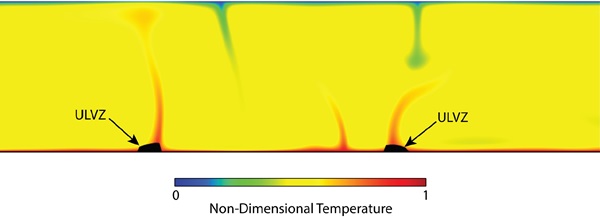Ultra-low velocity zones (ULVZs) are thin (~10 km) and wide (~100-1000 km) regions of strongly reduced seismic velocity and higher density found at the boundary between Earth’s rocky mantle and liquid core. So far, ULVZs have only been detected in some regions of Earth’s deep interior, but due to their small scale it is still unclear whether they exist as isolated patches or as the thicker manifestations of an otherwise globally thin layer that separates Earth’s mantle and core. A new model shows that they evolve into isolated “islands” of dense material, exposing the lower mantle to the liquid outer core away from ULVZs and reflecting the form of deep circulation within the Earth.

Seismology offers a powerful imaging tool to probe the Earth’s interior, as seismic waves generated by earthquakes travel through our planet at speeds that are highly sensitive to the chemical and physical characteristics of the layers they encounter. Detecting variations in the waves at seismographic arrays allows us to image these variations inside the Earth (like a CT-scan does for medical imaging). The boundary between Earth’s rocky mantle and liquid iron core (usually referred to as the core-mantle boundary or CMB) is a rich and mysterious environment, featuring a variety of seismically imaged structures with diverse length scales and strong anomalies. An example is the so-called ultra-low velocity zones (ULVZs), which are ~10 km thick patches that dramatically slow seismic waves, hinting at a different density and chemical composition relative to the rest of the mantle. These features are important for understanding the history and evolution of the core and mantle, and may reflect how the Earth formed and separated into layers.
Even with the large amount of seismic data available in the present day, ULVZs have only been detected in specific regions, and their origin, shape, and long-term evolution are still mysterious. Furthermore, the small size of ULVZs makes them challenging targets to resolve. However, the position of ULVZs at the CMB means that they may give important clues about the ancient history of core and mantle interactions deep inside the Earth, including core formation processes more than 4 billion years ago. A number of questions remain unanswered: 1) How did ULVZs contribute to how the Earth looks today and to what extent? 2) Do they reside on top of the core-mantle boundary acting as a “cap” that isolates the mantle from the core, or do they enable interactions and material exchange between these two reservoirs? 3) Does a global (very) thin and thus seismically undetectable ULVZ layer exist, or are the observed patches representative of ordinary lower mantle?
Unfortunately, modeling the evolution of ULVZs is not easy. As mentioned above, ULVZs are very small, and analyzing their evolution together with the whole mantle is very challenging and can lead to poor resolution and incorrect interpretations. A way of going around this problem is to incorporate the evolution of ULVZs through an equation, which can be introduced as a boundary condition to a given model. Using a complex equation with lots of unknowns can represent a problem. However, when we consider a global thin ULVZ layer, we can make some substantial simplifications, since the thickness of the ULVZ layer is much smaller than the length scale of motion in the mantle (Figure 1). The resulting ULVZ equation is readily added to analytical and numerical models of mantle convection.
How do ULVZs evolve? The results of these models show that when starting with a global ULVZ layer, ULVZ material accumulates to form compact piles or ridges on relatively short geological time scales. Vigorous motions inside the mantle drag fluid from the core-mantle boundary up to the surface, and bring material from shallow depths down to the lowermost mantle. Even if ULVZ material is denser and tends to “settle” back down due to its higher gravity, strong convective mantle motions sweep ULVZs in specific regions and cause them to accumulate over a long time (Figure 2). Of course, such an outcome is highly sensitive to a number of lower mantle characteristics, some of which are still poorly constrained. As an example, the order of magnitude of the effective viscosity (i.e., resistance to shearing deformation) of mantle rock is still unclear. However, our model shows that these properties can be constrained by the fraction of CMB occupied by ULVZ material, which may be a simpler target for seismological observations.
What do our results mean in term of Earth’s evolution? We found out that ULVZs are not a continuous structure at the CMB; instead, they look more like concentrated patches of material, which agrees well with seismic observations. This would imply that Earth’s mantle and core exchanged material in the past and also at present. As a matter of fact, while the core and the mantle look like two sharply separated entities, such interactions can be detected in lavas at the Earth’s surface when hot material is carried up from the deep mantle and melts.

| Journal | Journal of Geophysical Research: Solid Earth |
| Tile of the paper | Modeling Ultralow Velocity Zones as a Thin Chemically Distinct Dense Layer at the Core-Mantle Boundary |
| Authors | John W. Hernlund1, Irene Bonati1 |
| Affiliations | 1Earth-Life Science Institute, Tokyo Institute of Technology |
| DOI | 10.1029/2018JB017218 |
| Online published date | 30 June 2019 |
